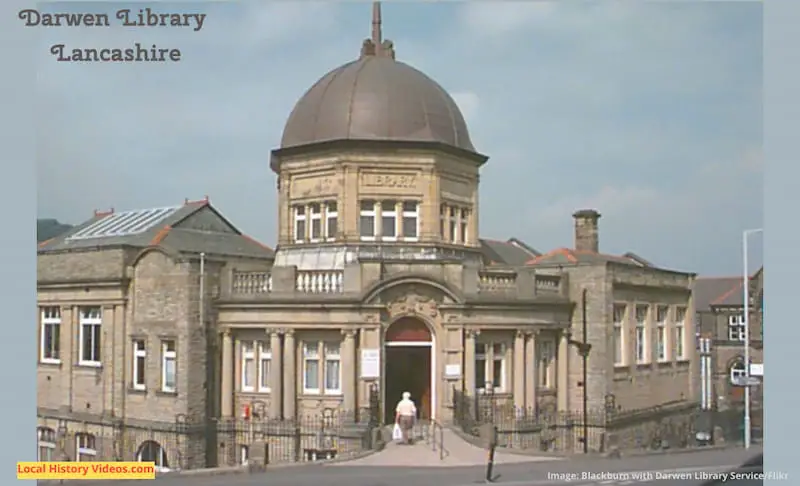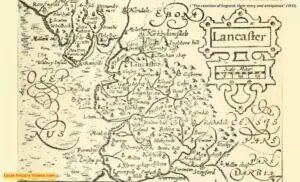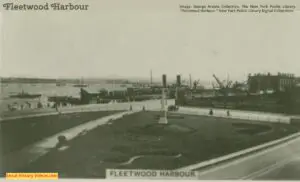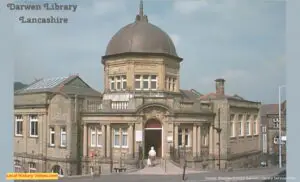Glimpse history of Darwen, Lancashire, in the North West of England, UK.
Darwen 1901
Mitchell and Kenyon toured around Britain, filmed busy streets or locations full of people, and by the evening had an edited film ready for screening to the local community. Customers flocked in to see if they could spot themselves or their children on screen.
The 800 rolls of Mitchell and Kenyon negatives ended up stored in three large metal drums in a basement in Northgate, Blackburn. In 1994, the basement was being cleared ready for demolition and the film rolls found by workmen. Wondering if the film had any value, they stopped off at Magic Moments Video on their way to Lethbridges Scrap Metal Processors. The owner had the film delivered to Peter Worden, who protected the film by placing the negative rolls in a chest freezer while both he and Robin Whalley researched the films and filmmakers. In July 2000, the BFI stepped in, cleaned and restored the frames, and saved this important archive.
One of the Mitchell and Kenyon films recorded a Darwen street in 1901.
Guy Jones has slightly altered this film, slowing it down to a natural rate and adding ambient sound.
Horses and carts move goods and passengers about, the electric tram travels by, a dog runs about wagging its tail, and adults try to make their way through the crowd of excited children jumping about and laughing at the camera.
1901 – Street Scene in Darwen, Lancashire (speed corrected w/ added sound) – guy jones on YouTube
Ghandi’s Visit 1931
On 28th September 1931, an Indian delegation, headed by Mahatma Gandhi and accompanied by Miss Slade, visited the cotton mills of Darwen.
The newsreel shows the huge number of local people who turned out to see the leader behind India’s peaceful quest for independence, a cause that Mahatma Gandhi joined in 1914.
His method of nonviolent protest known as satyagraha included encouraging Indians to stop buying British goods, avoid paying taxes to the British government, and take part in peaceful protests and marches. The Indian Independence Bill came into force at the stroke of midnight on August 15, 1947. It created the indepedent nations of India and Pakistan, releasing terrible violence because of poor, hurried planning by people with little understanding of the country, and lack of information to the nation’s communities which caused panic and overreaction. Ghandi was assassinated in New Delhi on 30 January 1948.
There are some uncomfortable moments in this film. The louder man, already having casually placed his arm around Ghandi to position him, then conveys Ghandi’s message about loving all of them as if they were his own children, with completely the wrong meaning of sending love to all the children of the world. Whilst that left the crowd somewhat baffled and quiet, it’s clear that the mill workers were very pleased to see him visiting their community.
Gandhi In Lancashire – British Movietone on YouTube
Historic Book
Extract from “History and Traditions of Darwen and Its People” by John George Shaw
Published in 1889
Pages 165-166
“A very serious epidemic of typhoid fever occurred in the year 1874 ,
and the Local Board of Health , whose primary duty it was to take care
of the sanitary condition of the town , had a very arduous and thankless
task to perform under unusual circumstances of difficulty . The first
case occurred on the 25th of September , at Woodside Bank , the house
of the Rev. Thomas Davies , whose daughter was stricken with it .
Three
weeks later , the newly – appointed Medical Officer of Health , Dr. George
Hindle , of Holker House , reported to the Local Government Board that
there were then between 500 and 600 cases of typhoid or enteric fever in
the district , and that the epidemic was almost precisely similar to one that
occurred in 1861 .
He attributed the epidemic primarily to the defec
tive sanitary condition of the town , adding- ” It is simply dirt fever ,
arising from bad drainage ; nightsoil lodged in imperfect cesspools , and
a large amount of filth and organic matter in other parts of the town . “
Dr. Stevens , an Inspector under the Local Government Board , imme
diately came down to Darwen , and going direct to the house where the
first case occurred , discovered by pulling up the drains that the water
supply of the town was polluted . Addressing the Local Board at a
special meeting the same day ( Oct. 31 ) he remarked that since the 8th of
October they had lost 44 lives , and that on the lowest computation there
were then 1200 cases of fever in the town . He said he had traced the
sewage of Mr. Davies’s house until it ” sucked itself into the pure water “
running through a porous stone drain from one reservoir to another , and
” there was as much dirty black matter as any one of them could be
steeped in . ” ” Hence , ” he said , ” they had this sudden flash of fever ,
which had broken out in all parts of the town , ” and ” the town was pre
pared for the distribution of any kind of disease , ” by its bad sanitary
condition . He described the scavenging system then carried out in
Darwen as ” a farce , a delusion , and a snare , ” and said that an enor
mous amount of work must be done in the way of drainage . ”
It subse
quently transpired that the pollution of the water by the drains of Wood
side Bank was suspected in 1861 , on the occasion of the former epi
demic , and that the authorities at that time , as they believed , effectually
stopped the sewage from getting into the conduit , but did not connect
the iron pipe which they put in to carry it safely across !
The Rev. H. H.
Moore , M.A. , Vicar of St , John’s , wrote a long letter in The Times ,
( London ) on November 2nd , severely criticising the neglect of the
Local Board to put the town into a proper sanitary condition , and
Darwen obtained an unenviable notoriety by the vivid pictures of its
benighted condition which were drawn by the leader – writers of the
London and provincial Press .
In November , the filtering – lodge of the
town’s water – supply was cleaned out , for the first time for 20 years , and
more evidences of contamination were brought to light .
The Local
Board at once laid a line of earthenware pipes along the porous stone
conduit of the water – supply , where the pollution had taken place , the cost
being £ 544 . They also had the water analysed , and Mr. R. Railton ,
F.C.S. , of Blackburn , twice reported emphatically that there was not the
slightest evidence in the samples submitted to him of animal or sewage
pollution . He said , ” You must look nearer to your river side for the
cause of the fever which is now raging in your town , rather than to your
water – supply . “
The first annual report of the Medical Officer showed that during the year 1874
there were 839 deaths in Darwen , the death – rate being 36.9 per 1000 of the popula
tion , against an average for the previous five years of 25.3 . The death – rate of the
United Kingdom for 1874 was 21.6. More than one – third of the total number of
deaths in Darwen were due to the zymotic diseases ; the zymotic death – rate being 12.9
per 1000 of the population , whilst for the whole of England and Wales it was only 3.6.
This was chiefly due to the epidemic , there being 114 deaths from enteric fever
during the last three months of the year . The Medical Officer added that in 222
cases the cause of death was not certified by any legally qualified medical practitioner .
More about Lancashire
- Old Images of Lancashire, England
- Old Images of Skelmersdale, Lancashire
- Old Images of Haslingden, Lancashire
- Old Images of Fleetwood, Lancashire
- Old Images of Darwen, Lancashire
More Lancashire local history resources
Back to Home Page





